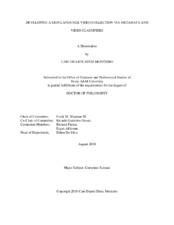| dc.description.abstract | Video sharing sites have become a central tool for the storage and dissemination of sign language content. Sign language videos have many purposes, including sharing experiences or opinions, teaching and practicing a sign language, etc. However, due to limitations of term-based search, these videos can be hard to locate. This results in a diminished value of these sites for the deaf or hard-of-hearing community. As a result, members of the community frequently engage in a push-style delivery of content, sharing direct links to sign language videos with other members of the sign language community. To address this problem, we propose the Sign Language Digital Library (SLaDL).
SLaDL is composed of two main sub-systems, a crawler that collects potential videos for inclusion into the digital library corpus, and an automatic classification system that detects and identifies sign language presence in the crawled videos. These components attempt to filter out videos that do not include sign language from the collection and to organize sign language videos based on different languages. This dissertation explores individual and combined components of the classification system. The components form a cascade of multimodal classifiers aimed at achieving high accuracy when classifying potential videos while minimizing the computational effort.
A web application coordinates the execution of these two subsystems and enables user interaction (browsing and searching) with the library corpus. Since the collection of the digital library is automatically curated by the cascading classifier, the number of irrelevant results is expected to be drastically lower when compared to general-purpose video sharing sites.
iii
Video sharing sites have become a central tool for the storage and dissemination of sign language content. Sign language videos have many purposes, including sharing experiences or opinions, teaching and practicing a sign language, etc. However, due to limitations of term-based search, these videos can be hard to locate. This results in a diminished value of these sites for the deaf or hard-of-hearing community. As a result, members of the community frequently engage in a push-style delivery of content, sharing direct links to sign language videos with other members of the sign language community. To address this problem, we propose the Sign Language Digital Library (SLaDL).
SLaDL is composed of two main sub-systems, a crawler that collects potential videos for inclusion into the digital library corpus, and an automatic classification system that detects and identifies sign language presence in the crawled videos. These components attempt to filter out videos that do not include sign language from the collection and to organize sign language videos based on different languages. This dissertation explores individual and combined components of the classification system. The components form a cascade of multimodal classifiers aimed at achieving high accuracy when classifying potential videos while minimizing the computational effort.
A web application coordinates the execution of these two subsystems and enables user interaction (browsing and searching) with the library corpus. Since the collection of the digital library is automatically curated by the cascading classifier, the number of irrelevant results is expected to be drastically lower when compared to general-purpose video sharing sites.
The evaluation involved a series of experiments focused on specific components of the system, and on analyzing how to best configure SLaDL. In the first set of experiments, we investigated three different crawling approaches, assessing how they compared in terms of both finding a large quantity of sign language videos and expanding the variety of videos in the collection. Secondly, we evaluated the performance of different approaches to multimodal classification in terms of precision, recall, F1 score, and computational costs. Lastly, we incorporated the best multimodal approach into cascading classifiers to reduce computation while preserving accuracy. We experimented with four different cascading configurations and analyzed their performance for the detection and identification of signed content. Given our findings of each experiment, we proposed the set up for an instantiation of SLaDL. | en |


